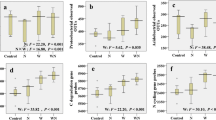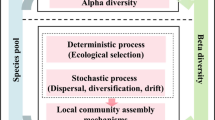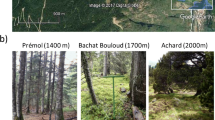Abstract
The composition of the soil microbiome is influenced by environmental (abiotic) variables and biological interactions (biotic factors). To determine whether the aboveground vegetation and soil physicochemical properties were the main determinant of beta-diversity and biological interaction of soil microbial community, we sampled soils from the temperate coniferous forest and grassland. Clustering of operational taxonomic units was conducted using 16S rRNA gene. We found that the microbial composition of the rhizospheres, in which root exudates influence the microbial environment, show lower alpha-diversity than that of nonroot soils. The nonsignificant rhizosphere effect suggested other undetermined factors or stochastic processes accounted for microbial diversity in the rhizosphere. More significant microbe-microbe interactions were observed in forest and rhizosphere soils relative to the grassland soils. The elevated number of positive correlations for relative abundances in forest soil implied beneficial associations being common among bacteria, in particular within the rhizosphere environment. The particular soil properties generated by root exudates also alter the physicochemical properties of soil such as K and pH value, and might in turn favor the adoption of teamwork-cooperation strategies for microbe-microbe interactions, represented as large clusters of positive associations among bacterial taxa. Specific biological interactions differentiated the microbiomes within forest soils. Thus, the environmental selection pressure of aboveground vegetation accounts for differences between soil microbiomes while biotic factors are responsible for fine-scale differences of the microbial community in forest soils.




Similar content being viewed by others
References
Berg G, Smalla K (2009) Plant species and soil type cooperatively shape the structure and function of microbial communities in the rhizosphere. FEMS Microbiol. Ecol. 68:1–13. doi:10.1111/j.1574-6941.2009.00654.x
Caruso T, Chan YK, Lacap DC, Lau MCY, Mckay CP, Pointing SB (2011) Stochastic and deterministic processes interact in the assembly of desert microbial communities on a global scale. ISME J 5:1406–1413. doi:10.1038/ismej.2011.21
Barra PJ, Inostroza NG, Acuña JJ, Mora ML, Crowley DE, Jorquera MA (2016) Formulation of bacterial consortia from avocado (Persea americana Mill.) and their effect on growth, biomass and superoxide dismutase activity of wheat seedlings under salt stress. Appl. Soil Ecol. 102:80–91
Lauber CL, Hamady M, Knight R, Fierer N (2009) Pyrosequencing-based assessment of soil pH as a predictor of soil bacterial community structure at the continental scale. Appl. Environ. Microbiol. 75:5111–5120. doi:10.1128/Aem.00335-09
Tripathi BM, Lee-Cruz L, Kim M, Singh D, Go R, Shukor NAA, Husni MHA, Chun J, Adams JM (2014) Spatial scaling effects on soil bacterial communities in Malaysian tropical forests. Microb. Ecol. 68:247–258. doi:10.1007/s00248-014-0404-7
Meola M, Lazzaro A, Zeyer J (2014) Diversity, resistance and resilience of the bacterial communities at two alpine glacier forefields after a reciprocal soil transplantation. Environ. Microbiol. 16:1918–1934. doi:10.1111/1462-2920.12435
Zhang XM, Johnston ER, Liu W, Li LH, Han XG (2016) Environmental changes affect the assembly of soil bacterial community primarily by mediating stochastic processes. Glob. Chang. Biol. 22:198–207. doi:10.1111/gcb.13080
Wang JJ, Shen J, Wu YC, Tu C, Soininen J, Stegen JC, He JZ, Liu XQ, Zhang L, Zhang EL (2013) Phylogenetic beta diversity in bacterial assemblages across ecosystems: deterministic versus stochastic processes. ISME J 7:1310–1321. doi:10.1038/ismej.2013.30
Andersson AF, Riemann L, Bertilsson S (2010) Pyrosequencing reveals contrasting seasonal dynamics of taxa within Baltic Sea bacterioplankton communities. ISME J 4:171–181. doi:10.1038/ismej.2009.108
Stegen JC, Lin XJ, Konopka AE, Fredrickson JK (2012) Stochastic and deterministic assembly processes in subsurface microbial communities. ISME J 6:1653–1664. doi:10.1038/ismej.2012.22
Hubbell SP (2005) Neutral theory in community ecology and the hypothesis of functional equivalence. Funct. Ecol. 19:166–172. doi:10.1111/j.0269-8463.2005.00965.x
Ma XJ, Chen T, Zhang GS, Wang R (2004) Microbial community structure along an altitude gradient in three different localities. Folia Microbiol 49:105–111. doi:10.1007/Bf02931382
Mitchell RJ, Hester AJ, Campbell CD, Chapman SJ, Cameron CM, Hewison RL, Potts JM (2012) Explaining the variation in the soil microbial community: do vegetation composition and soil chemistry explain the same or different parts of the microbial variation? Plant Soil 351:355–362. doi:10.1007/s11104-011-0968-7
Sundqvist MK, Giesler R, Graae BJ, Wallander H, Fogelberg E, Wardle DA (2011) Interactive effects of vegetation type and elevation on aboveground and belowground properties in a subarctic tundra. Oikos 120:128–142. doi:10.1111/j.1600-0706.2010.18811.x
Mummey DL, Clarke JT, Cole CA, O'Connor BG, Gannon JE, Ramsey PW (2010) Spatial analysis reveals differences in soil microbial community interactions between adjacent coniferous forest and clearcut ecosystems. Soil Biol. Biochem. 42:1138–1147. doi:10.1016/j.soilbio.2010.03.020
Ranjard L, Dequiedt S, Prevost-Boure NC, Thioulouse J, Saby NPA, Lelievre M, Maron PA, Morin FER, Bispo A, Jolivet C, Arrouays D, Lemanceau P (2013) Turnover of soil bacterial diversity driven by wide-scale environmental heterogeneity. Nat. Commun. 4:1434. doi:10.1111/ 143410.1038/Ncomms2431
Vos M, Wolf AB, Jennings SJ, Kowalchuk GA (2013) Micro-scale determinants of bacterial diversity in soil. FEMS Microbiol. Rev. 37:936–954. doi:10.1111/1574-6976.12023
Kusel K, Drake HL (1995) Effects of environmental parameters on the formation and turnover of acetate by forest soils. Appl. Environ. Microbiol. 61:3667–3675
Chaparro JM, Badri DV, Vivanco JM (2014) Rhizosphere microbiome assemblage is affected by plant development. ISME J 8:790–803. doi:10.1038/ismej.2013.196
Li XZ, Rui JP, Xiong JB, Li JB, He ZL, Zhou JZ, Yannarell AC, Mackie RI (2014) Functional potential of soil microbial communities in the maize rhizosphere. PLoS One 9:e112609. doi:10.1126/0910.1371/journal.pone.0112609
Burns JH, Anacker BL, Strauss SY, Burke DJ (2015) Soil microbial community variation correlates most strongly with plant species identity, followed by soil chemistry, spatial location and plant genus. AoB Plants 7: plv030. doi:10.1093/aobpla/plv030
Vega-Avila AD, Gumiere T, Andrade PAM, Lima-Perim JE, Durrer A, Baigori M, Vazquez F, Andreote FD (2015) Bacterial communities in the rhizosphere of Vitis vinifera L. cultivated under distinct agricultural practices in Argentina. Anton Leeuw. Int. J. G. 107:575–588. doi:10.1007/s10482-014-0353-7
Barea JM, Pozo MJ, Azcon R, Azcon-Aguilar C (2005) Microbial co-operation in the rhizosphere. J. Exp. Bot. 56:1761–1778. doi:10.1093/jxb/eri197
Karthikeyan R, Kulakow PA (2003) Soil plant microbe interactions in phytoremediation. Adv. Biochem. Eng. Biotechnol. 78:51–74
Bakker MG, Schlatter DC, Otto-Hanson L, Kinkel LL (2014) Diffuse symbioses: roles of plant-plant, plant-microbe and microbe-microbe interactions in structuring the soil microbiome. Mol. Ecol. 23:1571–1583. doi:10.1111/mec.12571
Lambers H, Mougel C, Jaillard B, Hinsinger P (2009) Plant-microbe-soil interactions in the rhizosphere: an evolutionary perspective. Plant Soil 321:83–115. doi:10.1007/s11104-009-0042-x
Flint HJ, Duncan SH, Scott KP, Louis P (2007) Interactions and competition within the microbial community of the human colon: links between diet and health. Environ. Microbiol. 9:1101–1111. doi:10.1111/j.1462-2920.2007.01281.x
Faust K, Raes J (2012) Microbial interactions: from networks to models. Nat Rev Microbiol 10:538–550. doi:10.1038/nrmicro2832
Wieland G, Neumann R, Backhaus H (2001) Variation of microbial communities in soil, rhizosphere, and rhizoplane in response to crop species, soil type, and crop development. Appl. Environ. Microbiol. 67:5849–5854. doi:10.1128/aem.67.12.5849-5854.2001
Ewing B, Green P (1998) Base-calling of automated sequencer traces using Phred. II. Error probabilities. Genome Res. 8:186–194. doi:10.1101/gr.8.3.186
Ewing B, Hillier L, Wendl MC, Green P (1998) Base-calling of automated sequencer traces using Phred.I. Accuracy assessment. Genome Res. 8:175–185. doi:10.1101/gr.8.3.175
Schloss PD, Westcott SL, Ryabin T, Hall JR, Hartmann M, Hollister EB, Lesniewski RA, Oakley BB, Parks DH, Robinson CJ, Sahl JW, Stres B, Thallinger GG, Van Horn DJ, Weber CF (2009) Introducing mothur: open-source, platform-independent, community-supported software for describing and comparing microbial communities. Appl. Environ. Microbiol. 75:7537–7541. doi:10.1128/AEM.01541-09
Edgar RC, Haas BJ, Clemente JC, Quince C, Knight R (2011) UCHIME improves sensitivity and speed of chimera detection. Bioinformatics 27:2194–2200. doi:10.1093/bioinformatics/btr381
Caporaso JG, Kuczynski J, Stombaugh J, Bittinger K, Bushman FD, Costello EK, Fierer N, Pena AG, Goodrich JK, Gordon JI, Huttley GA, Kelley ST, Knights D, Koenig JE, Ley RE, Lozupone CA, McDonald D, Muegge BD, Pirrung M, Reeder J, Sevinsky JR, Turnbaugh PJ, Walters WA, Widmann J, Yatsunenko T, Zaneveld J, Knight R (2010) QIIME allows analysis of high-throughput community sequencing data. Nat. Methods 7:335–336. doi:10.1038/nmeth.f.303
Cole JR, Chai B, Farris RJ, Wang Q, Kulam-Syed-Mohideen AS, McGarrell DM, Bandela AM, Cardenas E, Garrity GM, Tiedje JM (2007) The ribosomal database project (RDP-II): introducing myRDP space and quality controlled public data. Nucleic Acids Res. 35:D169–D172. doi:10.1093/nar/gkl889
Chazdon RL, Chao A, Colwell RK, Lin SY, Norden N, Letcher SG, Clark DB, Finegan B, Arroyo JP (2011) A novel statistical method for classifying habitat generalists and specialists. Ecology 92:1332–1343. doi:10.1890/10-1345.1
Hewitt JE, Anderson MJ, Thrush SF (2005) Assessing and monitoring ecological community health in marine systems. Ecol. Appl. 15:942–953. doi:10.1890/04-0732
Villnäs A, Norkko J, Hietanen S, Josefson AB, Lukkari K, Norkko A (2013) The role of recurrent disturbances for ecosystem multifunctionality. Ecology 94:2275–2287. doi:10.1890/12-1716.1
Legendre P, Legendre L (1998) Numerical Ecology, 2nd edn. Elsevier Science, Amsterdam,
Legendre P, Gallagher ED (2001) Ecologically meaningful transformations for ordination of species data. Oecologia 129:271–280. doi:10.1007/s004420100716
Rappe MS, Giovannoni SJ (2003) The uncultured microbial majority. Annu. Rev. Microbiol. 57:369–394. doi:10.1146/annurev.micro.57.030502.090759
Legendre P, Oksanen J, ter Braak CJF (2011) Testing the significance of canonical axes in redundancy analysis. Methods Ecol. Evol. 2:269–277. doi:10.1111/j.2041-210X.2010.00078.x
Michelsen A, Lisanework N, Friis I, Holst N (1996) Comparisons of understorey vegetation and soil fertility in plantations and adjacent natural forests in the Ethiopian highlands. J. Appl. Ecol. 33:627–642. doi:10.2307/2404991
Bratton SP (1976) Resource division in an understory herb community: responses to temporal and microtopographic gradients. Am. Nat. 110:679–693. doi:10.1086/283097
Blais A-M, Lorrain S, Plourde Y, Varfalvy L (2005) Organic carbon densities of soils and vegetation of tropical, temperate and boreal forests. In: Tremblay A, Varfalvy L, Roehm C, Garneau M (eds) Greenhouse gas emissions—fluxes and processes: hydroelectric reservoirs and natural environments. Springer, Berlin Heidelberg, Berlin, Heidelberg, pp. 155–185
Jobbágy EG, Jackson RB (2000) The vertical distribution of soil organic carbon and its relation to climate and vegetation. Ecol. Appl. 10:423–436. doi:10.1890/1051-0761(2000)010[0423:TVDOSO]2.0.CO;2
Fierer N, Bradford MA, Jackson RB (2007) Toward an ecological classification of soil bacteria. Ecology 88:1354–1364. doi:10.1890/05-1839
Yousuf B, Keshri J, Mishra A, Jha B (2012) Application of targeted metagenomics to explore abundance and diversity of CO2-fixing bacterial community using cbbL gene from the rhizosphere of Arachis hypogaea. Gene 506:18–24. doi:10.1016/j.gene.2012.06.083
Roux X, le Recous S, Attard E (2011) Soil microbial diversity in grasslands and its importance for grassland functioning and services. In: Lemaire G, Hodgson J, Chabbi A (eds) Grassland productivity and ecosystem services. CAB International, Oxfordshire, pp. 158–178
Bertin C, Yang XH, Weston LA (2003) The role of root exudates and allelochemicals in the rhizosphere. Plant Soil 256:67–83. doi:10.1023/A:1026290508166
Kraffczyk I, Trolldenier G, Beringer H (1984) Soluble root exudates of maize: influence of potassium supply and rhizosphere microorganisms. Soil Biol. Biochem. 16:315–322. doi:10.1016/0038-0717(84)90025-7
Dakora FD, Phillips DA (2002) Root exudates as mediators of mineral acquisition in low-nutrient environments. Plant Soil 245:35–47. doi:10.1023/a:1020809400075
Calvaruso C, Turpault M-P, Frey-Klett P (2006) Root-associated bacteria contribute to mineral weathering and to mineral nutrition in trees: a budgeting analysis. Appl. Environ. Microbiol. 72:1258–1266. doi:10.1128/aem.72.2.1258-1266.2006
Zelezniak A, Andrejev S, Ponomarova O, Mende DR, Bork P, Patil KR (2015) Metabolic dependencies drive species co-occurrence in diverse microbial communities. P Natl Acad Sci USA 112:6449–6454. doi:10.1073/pnas.1421834112
Ramette A, Tiedje JM (2007) Multiscale responses of microbial life to spatial distance and environmental heterogeneity in a patchy ecosystem. P Natl Acad Sci USA 104:2761–2766. doi:10.1073/pnas.0610671104
Coyte KZ, Schluter J, Foster KR (2015) The ecology of the microbiome: networks, competition, and stability. Science 350:663–666. doi:10.1126/science.aad2602
Broeckling CD, Broz AK, Bergelson J, Manter DK, Vivanco JM (2008) Root exudates regulate soil fungal community composition and diversity. Appl. Environ. Microbiol. 74:738–744. doi:10.1128/AEM.02188-07
Titman D (1976) Ecological competition between algae: experimental confirmation of resource-based competition theory. Science 192:463–465. doi:10.1126/science.192.4238.463
Schoener TW (1974) Resource partitioning in ecological communities. Science 185:27–39. doi:10.1126/science.185.4145.27
Thomas F, Hehemann JH, Rebuffet E, Czjzek M, Michel G (2011) Environmental and gut Bacteroidetes: the food connection. Front. Microbiol. 2:93. doi:10.3389/Fmicb.2011.00093
Redford AJ, Bowers RM, Knight R, Linhart Y, Fierer N (2010) The ecology of the phyllosphere: geographic and phylogenetic variability in the distribution of bacteria on tree leaves. Environ. Microbiol. 12:2885–2893. doi:10.1111/j.1462-2920.2010.02258.x
Kahle D, Wickham H (2013) Ggmap: spatial visualization with ggplot2. R Journal 5:144–161
Acknowledgements
This research was financially supported by the Fundamental Research Funds for the Central Universities to SHW and supported by the Ministry of Science and Technology, Taiwan (MOST 105-2628-B-003-001-MY3 and MOST 105-2628-B-003-002-MY3) to PCL. This article was also subsidized by the National Taiwan Normal University (NTNU).
Author information
Authors and Affiliations
Corresponding author
Ethics declarations
Conflict of Interest
The authors declare that they have no conflict of interest.
Electronic supplementary material
ESM 1
(DOCX 64 kb)
ESM 2
(XLSX 1922 kb)
Figure S1
Sampling map with satellite images generated using ggmap packages implemented in R [62]. The grassland soil is presented in red point, the rhizosphere soil is presented in blue point, and the forest soil is presented in green point. (GIF 518 kb)
Figure S2
Loading plots for DAPC of the relative abundance of microbiomes in sampled soils of the three sampling groups (grassland, under forest and rhizosphere) at the phylum level, for Archaea OTUs and for Bacteria OTUs. Gray lines indicate the threshold 0.1 to identify the main contributors. OTU435804 belongs to Euryarchaeota; OTU191208 belongs to Acidobacteria_Gp4. (GIF 274 kb)
Figure S3
Correlation matrices for microbial phyla of total samples and samples of each sample group. The upper four panels are presented in alphabetical order for comparing the correlation patterns of each microbial phylum; the lower four panels are presented in order of hierarchical clustering so as to reveal clustering patterns (number of clusters and cluster size). The codes for microbial phyla are: P1, Acetothermia; P2, Acidobacteria; P3, Actinobacteria; P4, Aminicenantes; P5, Aquificae; P6, Armatimonadetes; P7, Atribacteria; P8, Bacteroidetes; P9, BRC1; P10, Caldiserica; P11, candidate division WPS-1; P12, candidate division WPS-2; P13, candidate division ZB3; P14, Candidatus Saccharibacteria; P15, Chlamydiae; P16, Chlorobi; P17, Chloroflexi; P18, Cloacimonetes; P19, Crenarchaeota; P20, Cyanobacteria/Chloroplast; P21, Deferribacteres; P22, Deinococcus-Thermus; P23, Elusimicrobia; P24, Euryarchaeota; P25, Fibrobacteres; P26, Firmicutes; P27, Fusobacteria; P28, Gemmatimonadetes; P29, Hydrogenedentes; P30, Ignavibacteriae; P31, Latescibacteria; P32, Lentisphaerae; P33, Microgenomates; P34, Nitrospirae; P35, Omnitrophica; P36, Parcubacteria; P37, Planctomycetes; P38, Proteobacteria; P39, Spirochaetes; P40, SR1; P41, Synergistetes; P42, Tenericutes; P43, Thaumarchaeota; P44, Thermodesulfobacteria; P45, Thermotogae; P46, unclassified; P47, Verrucomicrobia. (GIF 1381 kb)
Rights and permissions
About this article
Cite this article
Wu, SH., Huang, BH., Huang, CL. et al. The Aboveground Vegetation Type and Underground Soil Property Mediate the Divergence of Soil Microbiomes and the Biological Interactions. Microb Ecol 75, 434–446 (2018). https://doi.org/10.1007/s00248-017-1050-7
Received:
Accepted:
Published:
Issue Date:
DOI: https://doi.org/10.1007/s00248-017-1050-7




